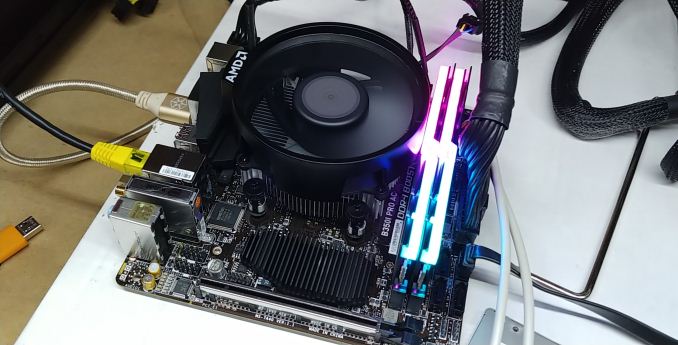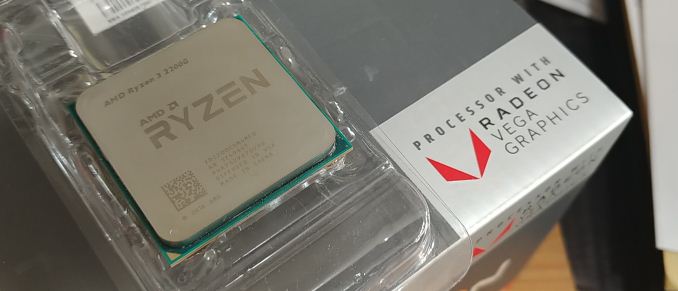Marrying Vega and Zen: The AMD Ryzen 5 2400G Review
by Ian Cutress on February 12, 2018 9:00 AM ESTConclusion: Raising the Bar for Integrated Graphics
The march on integrated graphics has come and gone in rapid spurts: the initial goal of providing a solution that provides enough performance for general office work has bifurcated into something that also aims gives a good gaming experience. Despite AMD and NVIDIA being the traditional gaming graphics companies, in this low-end space, it has required companies with x86 CPUs and compatible graphics IP to complete, meaning AMD and Intel. While going toe-to-toe for a number of years, with Intel dedicating over half of its silicon area to graphics at various points, the battle has become one-sided - Intel in the end only produced its higher performance solutions for specific customers willing to pay for it, while AMD marched up the performance by offering a lower cost solution as an alternative to discrete graphics cards that served little purpose beyond monitor output devices. This has come to a head, signifying a clear winner: AMD's graphics is the choice for an integrated solution, so much so that Intel is buying AMD's Vega silicon, a custom version, for its own mid-range integrated graphics. For AMD, that's a win. Now with the new Ryzen APUs, AMD has risen that low-end bar again.
If there was any doubt that AMD holds the integrated graphics crown, when we compare the new Ryzen APUs against Intel's latest graphics solutions, there is a clear winner. For almost all the 1080p benchmarks, the Ryzen APUs are 2-3x better in every metric. We can conclude that Intel has effectively given over this integrated graphics space to AMD at this point, deciding to focus on its encode/decode engines rather than raw gaming and 3D performance. With AMD having DDR4-2933 as the supported memory frequency on the APUs, assuming memory can be found for a reasonable price, it gaming performance at this price is nicely impressive.
When we compare the Ryzen 5 2400G with any CPU paired with the NVIDIA GT 1030, both solutions are within a few percent of each other in all of our 1080p benchmarks. The NVIDIA GT 1030 is a $90 graphics card, which when paired with a CPU, gets you two options: either match the combined price with the Ryzen 5 2400G, which leaves $80 for a CPU, giving a Pentium that loses in anything multi-threaded to AMD; or just increases the cost fo the system to get a CPU that is equivalent in performance. Except for chipset IO, the Intel + GT 1030 route offers no benefits over the AMD solution: it costs more, for a budget-constrained market, and draws more power overall. There's also the fact that the AMD APUs come with a Wraith Stealth 65W cooler, which adds additional value to the package that Intel doesn't seem to want to match.
For the compute benchmarks, Intel is still a clear winner with single threaded tests, with a higher IPC and higher turbo frequency. That is something that AMD might be able to catch up with on 12nm Zen+ coming later this year, which should offer a higher frequency, but Zen 2 is going to be the next chance to bridge this gap. If we compare the multi-threaded tests, AMD with 4C/8T and Intel 6C/6T seem to battle it out depending if a test can use multi-threading appropriately, but compared to Kaby Lake 4C/4T or 2C/4T offerings, AMD comes out ahead.
With the Ryzen 5 2400G, AMD has completely shut down the sub-$100 graphics card market. As a choice for gamers on a budget, those building systems in the region of $500, it becomes the processor to pick.
For the Ryzen 3 2200G, we want to spend more time analyzing the effect of a $99 quad-core APU the market, as well as looking how memory speed affects performance, especially with integrated graphics. There's also the angle of overclocking - with AMD showing a 20-25% frequency increase on the integrated graphics, we want to delve into how to unlock potential bottlenecks in a future article.












177 Comments
View All Comments
Gideon - Monday, February 12, 2018 - link
BTW Octane 2.0 is retired for Google (just check their github), and even they endorse using Mozillas Speedometer 2.0 (darn can't find the relevant blog post).Ian Cutress - Monday, February 12, 2018 - link
I know; in the same way we have legacy benchmarks up, some people like to look at the data.Not directed to you in general, but don't worry if 100% of the benchmarks aren't important to you: If there's 40 you care about, and we have 80 that include those 40, don't worry that the other 40 aren't relevant for what you want. I find it surprising how many people want 100% of the tests to be relevant to them, even if it means fewer tests. Optane was easy to script up and a minor addition, just like CB11.5 is. As time marches on, we add more.
kmmatney - Monday, February 12, 2018 - link
In this case, a few 720p gaming benchmarks would have been useful, or even 1080p at medium or low settings.III-V - Tuesday, February 13, 2018 - link
Who uses 720p and is in the market for this?PeachNCream - Tuesday, February 13, 2018 - link
I'm happy with 1366x768 and I'm seriously considering the 2400G because it looks like it can handle max detail settings at that resolution. I'm not interested in playing at high resolutions, but I do like having all the other non-AA eye candy turned on.atatassault - Tuesday, February 13, 2018 - link
People who buy sub $100 monitors.WorldWithoutMadness - Tuesday, February 13, 2018 - link
Just google GDP per capita and you'll find huge market for 720p budget gaming pc.Sarah Terra - Wednesday, February 14, 2018 - link
Wow, i just came here after not visiting in ages, really sad to see how far this site has fallen.Ian Cutress was the worst thing that ever happened to Anandtech.
At one point AT was the defacto standard for tech news on the web, but now it has simply become irrelevant.
Unless things change i see AT slowly but surely dying
lmcd - Friday, March 22, 2019 - link
Wow, I just came to this article after not visiting for ages, really sad to see how the comment section has fallenmikato - Thursday, February 15, 2018 - link
Me. My TV is 720p and still kicking after many years. These CPUs would make for a perfect high end HTPC with some solid gaming ability. Awesome.